| Listing 1 - 10 of 15 | << page >> |
Sort by
|
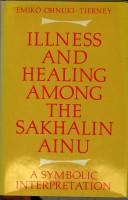
ISBN: 0521236363 Year: 1981 Publisher: Cambridge Cambridge University press
Abstract | Keywords | Export | Availability | Bookmark
 Loading...
Loading...Choose an application
- Reference Manager
- EndNote
- RefWorks (Direct export to RefWorks)
Ainu --- Medicine --- #SBIB:39A9 --- #SBIB:39A10 --- #SBIB:39A75 --- -Ainos --- Ethnology --- Medische antropologie / gezondheid / handicaps --- Antropologie: religie, riten, magie, hekserij --- Etnografie: Azië --- Medicine. --- -Medische antropologie / gezondheid / handicaps
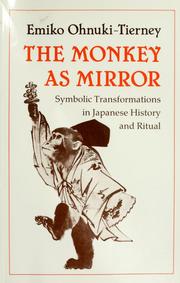
ISBN: 0691094349 Year: 1987 Publisher: Princeton Princeton University Press
Abstract | Keywords | Export | Availability | Bookmark
 Loading...
Loading...Choose an application
- Reference Manager
- EndNote
- RefWorks (Direct export to RefWorks)
J4109 --- J4100 --- J4203 --- Animals and civilization --- -Buraku people --- Monkeys --- -Haplorhini --- Primates --- Aeta (Japanese people) --- Burakumin (Japanese people) --- Eta --- Eta (Japanese people) --- Special-village people (Japanese people) --- Tokushu burakumin (Japanese people) --- Caste --- Ethnology --- Civilization and animals --- Civilization --- Human-animal relationships --- Japan: Sociology, anthropology and culture -- theory, methodology and philosophy --- Japan: Sociology, anthropology and culture in general --- Japan: Sociology and anthropology -- communities -- social classes and groups -- outcasts, burakumin, hinin --- Social aspects --- Japan --- Civilization. --- Buraku people. --- Social aspects. --- -Japan: Sociology, anthropology and culture -- theory, methodology and philosophy --- Buraku people --- Haplorhini --- J4000 --- Japan: Social sciences in general, social history
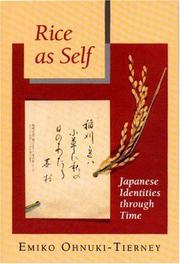
ISBN: 1282751743 9786612751745 1400820979 0691021104 9781400820979 1400812860 9781400812868 9780691021102 0691094772 9780691094779 Year: 1994 Publisher: Princeton, NJ
Abstract | Keywords | Export | Availability | Bookmark
 Loading...
Loading...Choose an application
- Reference Manager
- EndNote
- RefWorks (Direct export to RefWorks)
Are we what we eat? What does food reveal about how we live and how we think of ourselves in relation to others? Why do people have a strong attachment to their own cuisine and an aversion to the foodways of others? In this engaging account of the crucial significance rice has for the Japanese, Rice as Self examines how people use the metaphor of a principal food in conceptualizing themselves in relation to other peoples. Emiko Ohnuki-Tierney traces the changing contours that the Japanese notion of the self has taken as different historical Others--whether Chinese or Westerner--have emerged, and shows how rice and rice paddies have served as the vehicle for this deliberation. Using Japan as an example, she proposes a new cross-cultural model for the interpretation of the self and other.
Identity (Psychology). --- Japan. --- Japan - Civilization. --- Japan -- Civilization. --- National characteristics, Japanese. --- Rice. --- Rice -- Social aspects -- Japan. --- Social aspects. --- East Asia --- Regions & Countries - Asia & the Middle East --- History & Archaeology --- National characteristics, Japanese --- Rice --- Social aspects --- Lowland paddy --- Lowland rice --- Oryza sativa --- Paddy (Plant) --- Padi --- Palay --- Japanese national characteristics --- Oryza --- Personal identity --- Personality --- Self --- Ego (Psychology) --- Individuality --- Japan --- Bonin Islands --- #SBIB:39A10 --- #SBIB:39A5 --- #SBIB:39A75 --- Antropologie: religie, riten, magie, hekserij --- Kunst, habitat, materiële cultuur en ontspanning --- Etnografie: Azië --- Civilization. --- J4152 --- Japan: Sociology and anthropology -- customs, folklore and culture -- food
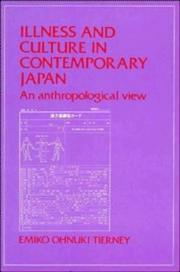
ISBN: 0521277868 0521259827 0511621779 0511869029 9780521277860 9780521259828 9780511621772 Year: 1984 Publisher: Cambridge Cambridge University Press
Abstract | Keywords | Export | Availability | Bookmark
 Loading...
Loading...Choose an application
- Reference Manager
- EndNote
- RefWorks (Direct export to RefWorks)
Health care in contemporary Japan - a modern industrial state with high technology, but a distinctly non-Western cultural tradition - operates on several different levels. In this book Emiko Ohnuki-Tierney provides a detailed and historically informed account of the cultural practices and cultural meaning of health care in urban Japan. In contrast to most ethnomedical studies, this book pays careful attention to everyday hygienic practices and beliefs, as well as presenting a comprehensive picture of formalized medicine, health care aspects of Japanese religions, and biomedicine. These different systems compete with one another at some levels, but are complementary in providing health care to urban Japanese, who often use more than one system simultaneously. As an unequalled portrayal of health care in a modern industrial, but non-Western, setting, it will be of widespread interest to scholars and students of anthropology, medicine, and East Asian studies.
Sociology of health --- Japan --- Medical anthropology --- Medical care --- Traditional medicine --- Social life and customs --- Social Sciences --- Anthropology --- Ethnic medicine --- Ethnomedicine --- Folk medicine --- Home cures --- Home medicine --- Home remedies --- Indigenous medicine --- Medical folklore --- Medicine, Primitive --- Primitive medicine --- Surgery, Primitive --- Alternative medicine --- Folklore --- Ethnopharmacology --- Medicine --- Anthropological aspects --- anthropology --- healing --- health care --- Chinese medicin --- Japanese medicin --- physiomorphism --- japanese culture --- japanese religions --- Kanpo (漢方) --- Traditional Japanese medicine (TJM)
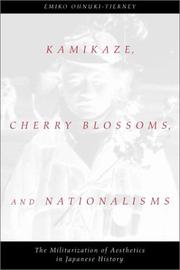
ISBN: 128267918X 9786612679186 0226620689 9780226620688 9780226620909 0226620905 0226620905 0226620913 9780226620916 Year: 2002 Publisher: Chicago University of Chicago press
Abstract | Keywords | Export | Availability | Bookmark
 Loading...
Loading...Choose an application
- Reference Manager
- EndNote
- RefWorks (Direct export to RefWorks)
Why did almost one thousand highly educated "student soldiers" volunteer to serve in Japan's tokkotai (kamikaze) operations near the end of World War II, even though Japan was losing the war? In this fascinating study of the role of symbolism and aesthetics in totalitarian ideology, Emiko Ohnuki-Tierney shows how the state manipulated the time-honored Japanese symbol of the cherry blossom to convince people that it was their honor to "die like beautiful falling cherry petals" for the emperor. Drawing on diaries never before published in English, Ohnuki-Tierney describes these young men's agonies and even defiance against the imperial ideology. Passionately devoted to cosmopolitan intellectual traditions, the pilots saw the cherry blossom not in militaristic terms, but as a symbol of the painful beauty and unresolved ambiguities of their tragically brief lives. Using Japan as an example, the author breaks new ground in the understanding of symbolic communication, nationalism, and totalitarian ideologies and their execution.
Kamikaze airplanes. --- World War, 1939-1945 --- Kamikaze pilots. --- College students --- Kamikaze bombers (Persons) --- Bomber pilots --- Kamikaze aeroplanes --- Suicide airplanes --- Bombers --- Aerial operations, Japanese. --- Education and the war. --- Aerial operations, Japanese --- Kamikaze airplanes --- Kamikaze pilots --- J4122 --- J6008.80 --- J6020 --- Education and the war --- Japan: Sociology and anthropology -- nationalism --- Japan: Art and antiquities -- history -- Gendai (1926- ), Shōwa period, 20th century --- Japan: Art and antiquities -- Japanese aesthetics (Japonism)
Book
ISBN: 0804795940 9780804795944 0804794103 9780804794107 9780804794107 9780804795890 Year: 2015 Publisher: Stanford, California
Abstract | Keywords | Export | Availability | Bookmark
 Loading...
Loading...Choose an application
- Reference Manager
- EndNote
- RefWorks (Direct export to RefWorks)
Flowers are beautiful. People often communicate their love, sorrow, and other feelings to each other by offering flowers, like roses. Flowers can also be symbols of collective identity, as cherry blossoms are for the Japanese. But, are they also deceptive? Do people become aware when their meaning changes, perhaps as flowers are deployed by the state and dictators? Did people recognize that the roses they offered to Stalin and Hitler became a propaganda tool? Or were they like the Japanese, who, including the soldiers, did not realize when the state told them to fall like cherry blossoms, it meant their deaths? Flowers That Kill proposes an entirely new theoretical understanding of the role of "idian symbols and their political significance to understand how they lead people, if indirectly, to wars, violence, and even self-exclusion and self-destruction precisely because symbolic communication is full of ambiguity and opacity. Using a broad comparative approach, Emiko Ohnuki-Tierney illustrates how the aesthetic and multiple meanings of symbols, and at times symbols without images become possible sources for creating opacity which prevents people from recognizing the shifting meaning of the symbols.
Symbolism in politics --- Symbolism in communication --- Flowers --- Blooms (Flowers) --- Blossoms --- Flowering plants --- Inflorescences --- Plants --- Floral products --- Communication --- Symbolic politics --- Political science --- History. --- Symbolic aspects
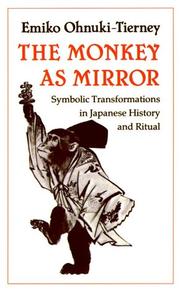
ISBN: 069102846X Year: 1989 Publisher: Guildford : Princeton University Press,
Abstract | Keywords | Export | Availability | Bookmark
 Loading...
Loading...Choose an application
- Reference Manager
- EndNote
- RefWorks (Direct export to RefWorks)
This tripartite study of the monkey metaphor, the monkey performance, and the 'special status' people traces changes in Japanese culture from the eighth century to the present. During early periods of Japanese history the monkey's nearness to the human-animal boundary made it a revered mediator or an animal deity closest to humans. Later it became a scapegoat mocked for its vain efforts to behave in a human fashion. Modern Japanese have begun to see a new meaning in the monkey--a clown who turns itself into an object of laughter while challenging the basic assumptions of Japanese culture and society.
Monkeys --- Animals and civilization --- Buraku people. --- Social aspects. --- Japan --- Civilization. --- Kultur --- Geschichte --- Affen --- Japanese culture --- Social aspects --- Sociological perspectives. --- Japan. --- Civilization --- Barbarism --- Civilisation --- Auxiliary sciences of history --- Culture --- World Decade for Cultural Development, 1988-1997 --- Haplorhini --- Primates --- Civilization and animals --- Human-animal relationships --- al-Yābān --- Giappone --- Government of Japan --- Iapōnia --- I︠A︡ponii︠a︡ --- Japam --- Japani --- Japão --- Japon --- Japonia --- Japonsko --- Japonya --- Jih-pen --- Mư̄ang Yīpun --- Nihon --- Nihon-koku --- Nihonkoku --- Nippon --- Nippon-koku --- Nipponkoku --- Prathēt Yīpun --- Riben --- State of Japan --- Yābān --- Yapan --- Yīpun --- Zhāpān --- Япония --- اليابان --- يابان --- 日本 --- 日本国 --- Azuma Kagami. --- Buddhism. --- Kojiki. --- Mountain Deity. --- Murasaki family. --- Nihongi. --- Oda Nobunaga. --- Ouwehand, C. --- Samson, G. --- Sarumaru Tayū. --- Shintoism. --- agriculture. --- ambiguity. --- anomalous symbol. --- catfish. --- cultured monkeys. --- dualism. --- dualistic cosmology. --- emotion. --- eta hinin. --- framing. --- healing, meaning of. --- hierarchy of meaning. --- historical actors. --- historical regularities. --- human-animal relationship. --- impurity. --- indexicality. --- inversion. --- kawaramono. --- laughter. --- long-term study of culture. --- marginals. --- mirror. --- multivocal symbols. --- non-agrarian population. --- nonresidents. --- oxen. --- performance. --- pronouns. --- radical negativity. --- reflexive monkey. --- reflexive symbol. --- residents. --- sansho. --- scapegoat. --- shomoji. --- sign. --- social position. --- stranger-deity. --- taboo. --- trickster. --- Jepun --- Yapon --- Yapon Ulus --- I︠A︡pon --- Япон --- I︠A︡pon Uls --- Япон Улс --- Tiere --- Tierdarstellung --- Motiv --- Landesgeschichte --- Regionalgeschichte --- Ortsgeschichte --- Zeitgeschichte --- Geschichtsphilosophie --- Vergangenheit --- I͡Aponii͡
Book
Year: 1994 Publisher: Princeton : Princeton University Press,
Abstract | Keywords | Export | Availability | Bookmark
 Loading...
Loading...Choose an application
- Reference Manager
- EndNote
- RefWorks (Direct export to RefWorks)
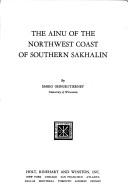
ISBN: 0030069262 Year: 1974 Publisher: New York : Holt, Rinehart and Winston,
Abstract | Keywords | Export | Availability | Bookmark
 Loading...
Loading...Choose an application
- Reference Manager
- EndNote
- RefWorks (Direct export to RefWorks)
Ethnology --- Ainu --- Aïnou (Peuple d'Asie)
Book
ISBN: 9782705686758 Year: 2013 Publisher: Paris : Hermann,
Abstract | Keywords | Export | Availability | Bookmark
 Loading...
Loading...Choose an application
- Reference Manager
- EndNote
- RefWorks (Direct export to RefWorks)
L'opération Tokkôtai, qui mit fin à la guerre du Pacifique, envoya des milliers de jeunes Japonais, étudiants des meilleures universités, à la mort. Cette étude éclaire leur engagement en analysant le développement de la militarisation des masses. L'examen détaillé des journaux intimes des pilotes témoigne de leur volonté de résister à l'impérialisme politique et culturel de l'Occident.
World War, 1939-1945 --- Kamikaze airplanes --- Nationalism --- 2ème guerre mondiale --- Kamikazes (Avions) --- Nationalisme --- Aerial operations, Japanese --- Symbolic aspects --- Opérations aériennes japonaises --- Aspect symbolique
| Listing 1 - 10 of 15 | << page >> |
Sort by
|

 Search
Search Feedback
Feedback About UniCat
About UniCat  Help
Help News
News